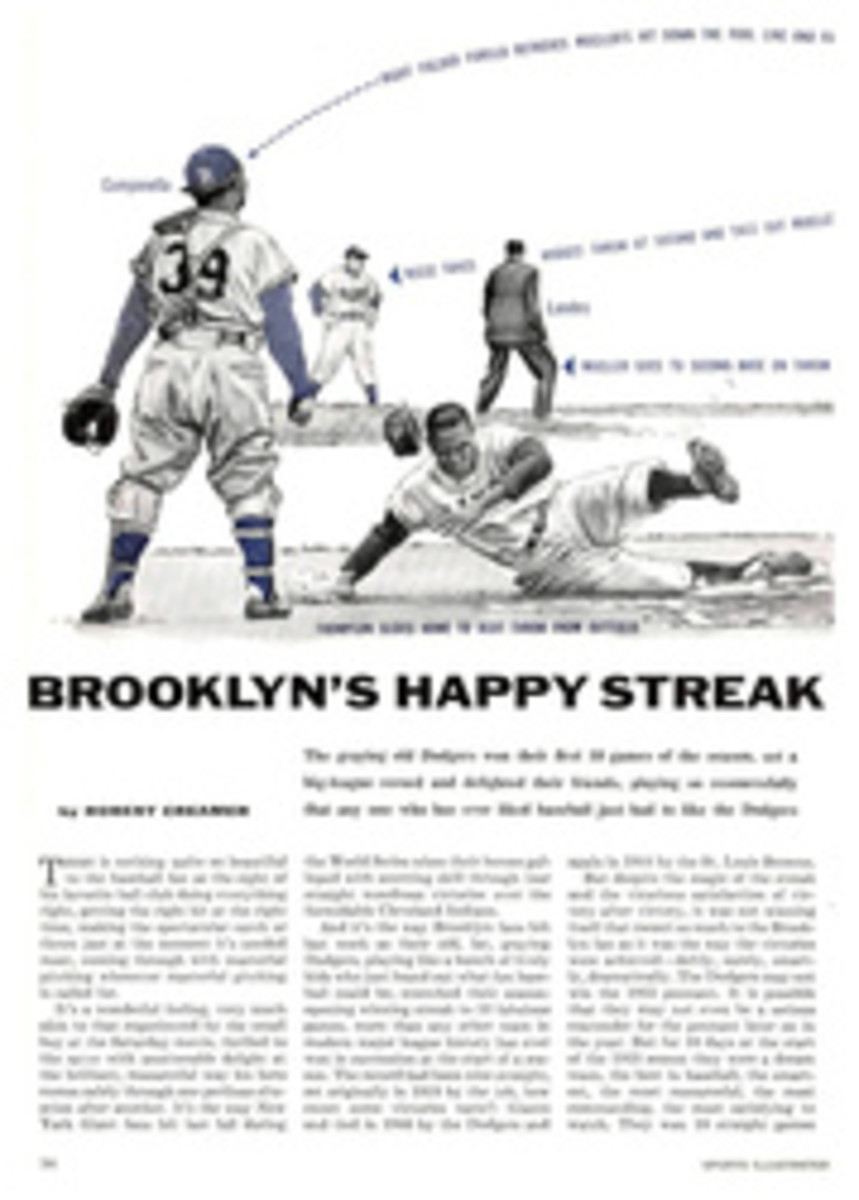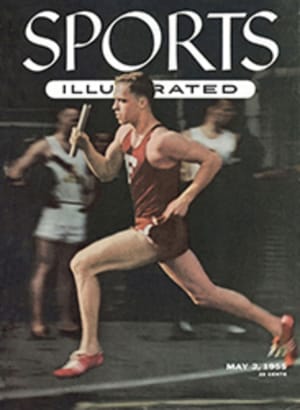
THE RELAYS!
Relay carnivals abound in the U.S., although they are they are all but unknown elsewhere in the world. They arrive early in spring with the crocus and the first small, green leaves, and they last through April and into May. What with Florida Relays and Ohio Relays and Arkansas Relays, Texas, Kansas and California Relays, Drake, Penn and West Coast Relays, hardly a week of spring goes by in one section or another of the country that a track fan cannot find a relay carnival to wallow in.
A relay carnival is simply a track meet in which relay races take precedence over races for individuals, unlike standard track meets or Olympic Games, in which relays are thrown in just to round out the program of individual races. Relay carnivals have races for individuals, too, sometimes very important races, but they are froth on the pudding. The relays are the thing.
Numbers are the thing, too. Rather than present a choice field of five or six top-flight competitors in each of 14 or 15 events, relay directors like Tommy Deckard of Drake University or Jerry Ford of the University of Pennsylvania think nothing of crowding nine or 10 teams of four men each into one event, and of running off 50 or 100 events, including trial heats, in a weekend.
This sometimes makes for confusion, as when a spectator who has come to see Oklahoma A&M's remarkable distance-medley team or Syracuse's championship two-mile quartet finds himself instead completely wrapped up in contemplation of a bevy of junior high school kids fighting it out, tooth, nail, elbow and heel, in a quarter-mile relay. But it also makes for a gala spectacle, rare excitement, pure competition and, on more than one occasion, great running. Anyway, a real track fan would rather see an exciting race between nondescripts than a dull one between stars. And he'd rather see a dull race—no matter who is in it—than no race at all.
Nevertheless, this bewildering panorama of thousands on thousands of skinny legs, pumping arms, gasping mouths and worn, weary faces is utterly incomprehensible to the non-track fan and has led one man, who considers all track and field idiotic, to describe relay racing as "the highest form of idiocy."
Why relay fans love this "idiocy"—whether the accusation is justified or not—is probably best explained by an old German-American maxim that can be applied, with equal charm and disregard for logic, to medicine, food or track and field. It says, "If a little bit is good, a whole lot is better." A whole lot is what the track fan gets at relays.
Consider. One of the most exciting things to watch at a track meet is a sprint, at 100 or 220 yards. Here men run at maximum effort, saving nothing, driving all the way. The trouble is, the race is over too soon. Ten seconds, 20 seconds—that's all there is. And if one of the competitors is clearly superior to the others, the race is often decided in the first 20 or 30 yards.
But in a quarter- or half-mile relay between teams of top-ranking sprinters you not only have all the wild abandon and extravagant effort of the ordinary sprint races, but you have it four times as long, and you also have the very distinct possibility of your one really great sprinter being set off several yards behind in the anchor (or final) leg of the relay, faced with the problem of catching up to and passing a rival sprinter almost as good as himself, and, to the delight of the track fan, often solving the problem in a breath-taking finish.
This holds true for other relay races, too. The quarter-mile (for individuals) is often called the most exciting race to watch in the standard track meet. It is run at near sprint speed, yet it is sufficiently long to require a certain precise pacing or rating of the runner. It is run around one or two curves, which brings in racing tactics (unless the event is run in lanes, an unhappily common practice nowadays). Multiply this fine race four times—which is what the one-mile relay is—and you have, for the relay fan, the ultimate in running: a slam-bang race all the way over a fairly long distance.
In the longer relays, those in which individual legs of a half-mile or longer are run, it is not at all uncommon for a previously unheralded runner to suddenly find within himself a large and potent store of hitherto unrealized ability.
For example, at the Drake Relays in 1952, Wes Santee, then a little known University of Kansas sophomore, was sent off 40 yards behind Georgetown's Joe LaPierre—who later that year won the IC4A mile championship—on the final leg of the grueling four-mile relay. He ran a brilliant 4:07.5-mile leg, much faster than he had ever run the mile before, and caught LaPierre in the stretch to give Kansas first place and a new American collegiate record. The next day in the distance medley he started his anchor leg even farther behind, trailing Michigan State's Jim Kepford, but once again ground the margin down and down and caught Kepford on the last backstretch, this time turning in a 4:07.4 effort to give Kansas another victory and a meet record.
No track fan who saw the then obscure Santee burst upon the American track-and-field scene that weekend will ever forget it. Nor, if he can help it, will he ever miss another relay carnival.
Nor will they who watched the Penn Relays in 1937, 1938 and 1939 forget John Woodruff, the very tall and graceful half-miler from the University of Pittsburgh who had won the 1936 Olympic 800 meters. Woodruff, challenged really to prove his greatness, responded by sparking seven Pitt relay teams to victory in those three years, running brilliant legs at distances from 220 to 880 yards. Around Franklin Field they still talk about Woodruff in tones of awe.
Franklin Field is on the awe-inspiring side to begin with, because it is the birthplace of modern relay running. It all started in 1895 when Frank B. Ellis, chairman of Pennsylvania's track committee, was looking around for a suitable event to mark the dedication of the school's newly built stadium—Franklin Field. He recalled that two years earlier, during his senior year at Penn, his school and Princeton had engaged in a one-mile relay race in which four runners from each school each ran a quarter of a mile. That race in turn had been an outgrowth of intramural relay races held at Penn.
Ellis and others arranged a series of relay races to take place on Saturday afternoon, April 20, 1895. A total of 64 competitors from eight colleges, six prep schools and two high schools took part. Eight two-team races were run with Harvard beating Penn in the mile-relay feature in 3:34.4.
In succeeding years the relay idea grew. In 1908 the Olympics adopted relay racing, and in 1910 Drake University followed suit. At Drake's first meet, run in a snow storm, a chilled group of 82 competitors were barely outnumbered by a crowd of 100. But in succeeding years the Drake Relays flourished and by the 1920s were rivaling Penn. Since then the two have stood side by side as twin titans of the relay world, competing once in a while for some of the better teams but for the most part content to rest on prized laurels: Penn on its tradition, its size and its age; Drake on its parade, its bands, its Relays Queen and its slightly better records over the years.
But when all is said and done, those in charge at both Penn and Drake will agree that the key man at either meet this year is, as always, that skinny little kid running the second leg of the high school medley. He is what relay racing is all about: competition.
[originallink:10460651:42867]
PHOTO
BOTH FEET OFF GROUND, sprinter Dean Smith lifts baton into palm of teammate Alvin Frieden, already in full stride, as crack Texas team takes big lead in 440-yard relay at Dallas.
PHOTO
STRETCH SPURT in Texas Relays distance medley carries Oklahoma A&M's Sture Landqvist to one-yard decision over pacesetter Al Frame of Kansas in record 10:05.3.
PHOTO
ANCIENT O'BRIEN
This undraped fellow, who looks like a forward passer caught with his pants down, is actually dressed for the sport in which he is competing. He is an athlete of the late fifth century putting a stone, and he is preserved in Etruscan bronze at the museum of Bologna, Italy.

